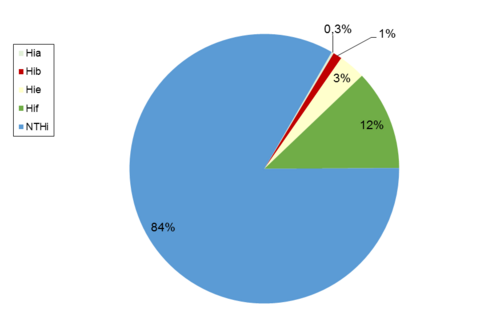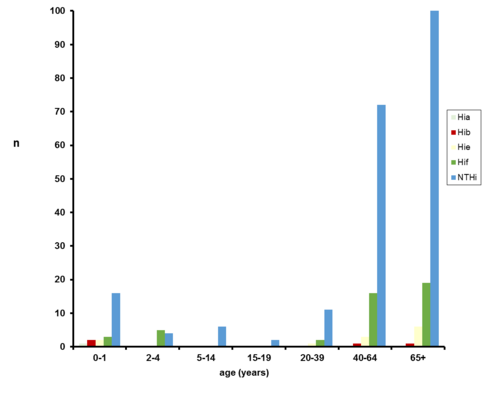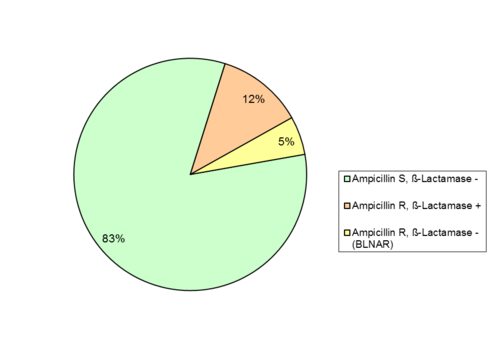Daten 2015 en
Data of the NRZMHi for Haemophilus influenzae 2015
1. Introduction
The tasks of the National Reference Laboratory for Meningococci and Haemophilus influenzae (NRZMHi) assigned by the Robert Koch Institute for the surveillance of invasive Haemophilus influenzae disease include serotyping of clinical isolates from blood or cerebrospinal fluid (CSF) and the detection of antibiotic resistance against ß-lactam antibiotics.
In 2015 all in all 456 submissions were analysed. In 385 submissions, bacterial isolates from blood or CSF were provided to the NRZMHi. Detection of H. influenzae from these materials has to be notified according to the German Infection Protection Act (IfSG). We received pairs of blood as well as CSF isolates from two patients.
Out of the total number of 385submissions from blood or CSF, 374 H. influenzae viable isolates from individual patients could be typed (97%). Two strains were H. haemolyticus, one H. parainfluenzae. In eight submissions, H. influenzae could not be cultivated from the sample.
The vast majority of blood or CSF isolates were non-typeable H. influenzae (NTHi, 312 isolates, 83.4 %), followed by Hif as the most frequent capsular serotype (45 cases; 12.0 %). Hie showed third highest frequency among the serotypes (12 cases; 3.2 %). Serotype b (Hib), the most frequent serotype before the general introduction of the Hib vaccination, was only reported in 4 cases (1.0 %). Two of these cases were children aged less than two years that had not yet received the full course of Hib vaccination. The other two cases were infections in elderly patients. Of the rare serotypes, one Hia, and no Hic or Hid were isolated. Of the 374 cases with invasive H. influenzae disease, the age group most affected was > 40 years (319 cases, 85.3 % of all cases). In addition, a significant percentage of cases (33 cases, 8.8 %;) was found in children aged <5 years.
The NRZMHi analyzed the frequency of ampicillin resistance using gradient agar diffusion tests (E-test). Sixty-five isolates (17.4 %) were ampicillin resistant (MIC > 1 µg/ml), of which 45 (69.2 %) showed β‑lactamase production. The percentage of β-lactamase negative ampicillin resistant (BLNAR) H. influenzae was 5 % of all tested isolates.
2. Serotype distribution of H. influenzae isolates from blood or CSF in 2014

3. Age distribution of patients with H. influenzae detected in blood or CSF

4. Serotype distribution in Federal States
| BW | BY | BE | BB | HB | HH | HE | MV | NI | NW | RP | SL | SN | SA | SH | TH | abr |
Hia | 1 | 0 | 0 | 0 | 0 | 0 | 0 | 0 | 0 | 0 | 0 | 0 | 0 | 0 | 0 | 0 | 0 |
Hib | 1 | 0 | 1 | 0 | 0 | 0 | 0 | 0 | 0 | 2 | 0 | 0 | 0 | 0 | 0 | 0 | 0 |
Hie | 2 | 1 | 1 | 0 | 0 | 0 | 1 | 0 | 1 | 3 | 1 | 0 | 1 | 0 | 0 | 0 | 1 |
Hif | 11 | 6 | 1 | 0 | 1 | 0 | 2 | 0 | 2 | 10 | 7 | 0 | 0 | 0 | 2 | 3 | 0 |
NTHi | 49 | 61 | 13 | 7 | 1 | 7 | 12 | 5 | 15 | 82 | 12 | 5 | 17 | 6 | 9 | 4 | 3 |
Total | 64 | 68 | 16 | 7 | 2 | 7 | 15 | 5 | 18 | 97 | 20 | 5 | 18 | 6 | 11 | 7 | 4 |
BW: Baden-Württemberg, BY: Bavaria, BE: Berlin, BB: Brandenburg, HB: Bremen, HH: Hamburg, HE: Hesse, MV: Mecklenburg-Western Pomerania, NI: Lower Saxony, NW: North Rhine-Westfalia, RP: Rhineland-Palatinate, SL: Saarland, SN: Saxony, ST: Saxony-Anhalt, SH: Schleswig-Holstein, TH: Thuringia, abr: abroad.
5. Serotype distribution according to site of isolation
Hib | Hie | Hif | NTHi | Total | |
Blood | 3 | 10 | 43 | 294 | 349 |
CSF | 1 | 2 | 2 | 17 | 22 |
both | 0 | 0 | 0 | 2 | 2 |
6. Ampicillin resistance in isolates H. influenzae from blood or CSF

7. Publications of the NRZMHi on Haemophilus influenzae:
Original Articles
- Lâm TT, Elias J, Frosch M, Vogel U, Claus H. New diagnostic PCR for Haemophilus influenzae serotype e based on the cap locus of strain ATCC 8142. Int J Med Microbiol. 2011 Feb;301(2):176-9.
- Lâm TT, Frosch M, Claus H, Vogel U. Sequence analysis of the serotype-specific synthesis regions II of Haemophilus influenzae serotypes c and d: evidence for common ancestry of capsule synthesis in Pasteurellaceae and Neisseria meningitidis. Research in Microbiology 2011 Jun;162(5):483-7.
- Lâm, T.T., Claus, H., Elias, J., Frosch, M., Vogel, U., 2015b. Ampicillin resistance of invasive Haemophilus influenzae isolates in Germany 2009-2012.Int J Med Microbiol. 2015 Oct;305(7):748-55.
- Lâm, T.T., Claus, H., Frosch, M., Vogel, U., 2016. Analysis of non-typeable Haemophilus influenzae in invasive disease reveals lack of the capsule locus. Clin Microbiol Infect. 2016 Jan;22(1):63.e7-8
Reviews
- Lâm TT, Claus H, Elias J, Hellenbrand W, Imöhl M, Prelog M, Sing A, van der Linden M, Vogel U. Infections with Pneumococci, Menigococci, H. influenzae and Diphtheria in Germany: the RKI Reference Network for Invasive Bacterial Infections (IBI) at the 5th Würzburg Workshop on Epidemiology, Prevention and Therapy for Invasive Meningococcal Diseases 2010 (Meeting Report). Gesundheitswesen. 2011. DOI: 10.1055/s-0031-1286269.
Disclaimer: the above data were generated with federal funds (RKI). Scientific use is prohibited without prior written consent by KLHi or RKI. Commercial use is strictly prohibited. Inclusion of figures or tables in talks or oral presentations is not allowed.

